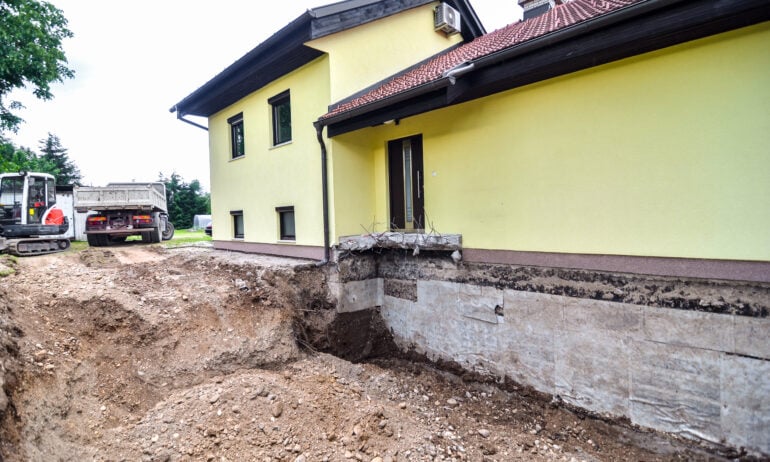How Much Does Foundation Repair Cost in 2025?
The cost to fix a foundation can vary from a few hundred dollars to $100,000, depending on the type of damage and extent of repairs needed.

Some or all of the mortgage lenders featured on our site are advertising partners of NerdWallet, but this does not influence our evaluations, lender star ratings or the order in which lenders are listed on the page. Our opinions are our own. Here is a list of our partners.
Foundation issues can be especially stressful for homeowners — particularly when your foundation repair cost falls at the high end of the spectrum, ranging from a few hundred dollars to $35,000 or more.
This guide breaks down costs for fixing different types of foundation damage, signs for determining whether your foundation needs repairs and options to pay for the work.
Average costs for foundation repair
For foundation repair projects, homeowners pay an average of $5,166, with a normal range of $2,219 to $8,113, according to Angi. But the actual cost to fix a foundation can vary widely depending on the severity of your issue and repair method it requires. Here’s a general rule of thumb.
Severity | Cost estimate | Repair examples |
|---|---|---|
Minor cosmetic and early-stage issues. | $250 to $1,000. | Sealing cracks, patching walls. |
Moderate issues that haven’t yet caused major structural damage. | $2,000 to $11,000. | Installing piers to lift one corner of a home, bracing a basement wall. |
Major issues with foundation significantly shifting or having widespread damage. | $15,000 to $35,000 or more. | Extensive piering under a home, foundation lifting. |
To save on your costs, make sure to get estimates from multiple contractors in writing. For major work to your home’s foundation, you may decide to choose reputation over the lowest bid, but it’s still a good idea to compare. Also, ask for and check references.
HELOC & Home Equity Loans from our partners

on FourLeaf Federal Credit Union
670
$1,000,000
on FourLeaf Federal Credit Union
How to know if you need foundation repair
You might suspect foundation problems after noticing signs, such as cracked walls, water leaks, sticking doors and windows, uneven floors or bowing basement walls. But the only way to truly diagnose the situation is to get a professional inspection.
Foundation repair contractors usually offer free inspections, but it’s important to realize they could overemphasize problems due to the financial incentive of getting the business.
Another option is to hire a residential structural engineer for an unbiased evaluation. This can be costly reaching $1,200 or more when related to suspected foundation problems, but having an engineer’s written report could help you save in other ways, for example when seeking competitive quotes for contractors to do the actual work.
If you hire a structural engineer to investigate foundation issues, the National Council of Examiners for Engineering and Surveying (NCEES) has a directory of member licensing boards by state. This can help you find your state licensing board’s site, where you can verify an engineer is licensed.
What affects the cost to fix foundation problems?
Several factors influence how much it will cost to repair your foundation:
1. Type and extent of damage
Foundation cracks without other damage present could be a DIY project using an epoxy injection kit ($100 to $400).
Sinking foundations may need only a few or multiple steel piers ($1,000 to $3,000 per pier).
In extreme cases, a house may need to be lifted to replace the entire foundation ($20,000 to $100,000).
2. Foundation type and size
Basement foundations may require waterproofing. Slab foundations could need slabjacking, which is the leveling of concrete. Crawl spaces may demand extra labor for access. Also, larger homes with bigger foundations can require more complex solutions that drive up costs.
3. Soil conditions and stability
Expansive clay soil and poor drainage can lead to more severe (and expensive) issues. Although it isn’t always necessary, in some cases you might need to pay for a professional soil report to understand your foundation issues. These reports can range from $500 to $3,000.
4. Location
Labor and material costs vary across the U.S., and homes in high-risk areas (earthquakes, floods) may need additional reinforcements, leading to higher costs.
5. Accessibility
If heavy equipment or deep excavation is needed, labor costs increase. Also, removal and replacement of landscaping, porches, decks or other items can add to final costs.
Ways to pay for foundation repairs
Your contractor may offer some financing options (either through a partner or a payment plan), but there are other — and maybe better — financing options available.
Home equity loan or HELOC
Home equity loans or home equity lines of credit (HELOC) may have lower interest rates than financing through a contractor’s lender, as well as possible tax benefits. Both options use your home as collateral.
Home equity loan. This may be a good option if you just want to pay for the foundation repair and won’t need ongoing access to money for additional repairs. With a home equity loan, you receive a lump-sum payment and then pay it back at a fixed interest rate over an agreed period of time, typically five to 30 years
Home equity line of credit. HELOCs work more like a credit card, so you have ongoing access to money as you need it. You usually have 10 years to draw from the line of credit and pay interest only on the HELOC amount you use. Most lenders have an option for interest-only payments during that time, after which you’re required to pay both the principal and interest. HELOC interest rates typically are variable, meaning your monthly payment could rise or fall over time.
Nerdy Perspective
After living in my home 25-plus years, I began noticing cracks in the plaster, doors not shutting, windows sticking and gutters not draining. In 2024, an inspection revealed my foundation was sinking causing major damage, and I needed numerous steel piers to be placed under my home. The process would also require the removal of my deck (which was already falling apart) and my concrete front porch to access beneath my house. Repairs weren’t covered by homeowner’s insurance, which is often the case for foundation problems. And estimates (which included replacing the deck, porch and gutters) were coming in above $50,000. Because I knew the project would occur in phases, I opted for a home equity line of credit (HELOC) which enabled me to pay for each part as it was completed. I’m paying extra each month to reduce my balance faster, and I now have a handy line of credit for any future home repairs.

Personal loan
Many banks, credit unions and online lenders offer personal loans, with amounts typically from $1,000 to $100,000 and with fixed annual percentage rates. You receive a lump sum and repay it in equal monthly installments over a set period, typically two to seven years. Unlike with home equity financing, there is no collateral. This means your home isn’t at risk if you get behind on payments, but you’ll still have to pay late fees and late payments can negatively impact your credit. Here are NerdWallet’s picks for the best home improvement loans.
Credit Card
Credit cards may be an option for lower cost foundation repairs. That’s because credit cards typically charge higher interest rates than home equity loans, HELOCs and personal loans. When used responsibly, credit cards can come with great benefits, such as 0% introductory APR periods that allow you to avoid interest for a set number of months; rewards so you earn cash back, travel or points; and sign-up bonuses that give you extra cash back or rewards for a larger purchase. If you go this route, you’ll want to make sure you choose one of the best credit cards for home improvements.
Final thoughts on foundation repair
Foundation problems can be serious and shouldn’t be ignored. Knowing how much foundation repair costs, what factors affect pricing and how to finance the work can help you make informed decisions.
If you notice signs of trouble, schedule a professional inspection and act quickly. Addressing issues early can mean the difference between a $1,000 repair and a $20,000-plus overhaul.
HELOC & Home Equity Loans from our partners

on FourLeaf Federal Credit Union
670
$1,000,000
on FourLeaf Federal Credit Union









